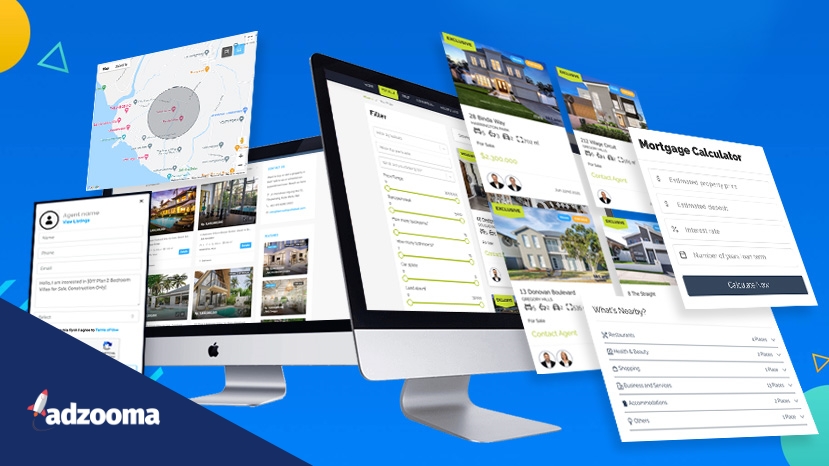Nearly 95% of home shoppers will turn to their mobile devices or laptops to shop for homes, according to a study from the National Association of REALTORS®.
This has changed greatly from years ago when homebuyers would begin their journey of finding a home from a local newspaper or real estate brochures.
Being the best real estate agent may not be enough these days. While you may be very knowledgeable in this field and your local market, another agent who has a more prominent online presence can potentially reach more clients before you.
“The first step toward success in the real estate business is to build a website that helps to generate leads and convert them effectively,” says Chad Egan, CEO of Geonet, with a division specialized in digital marketing for real estate.
“With a powerful lead-generation online marketing strategy, like the ones we implement for our clients, you are essentially exposing your services to a larger number of internet users and potential clients. Your website must be the cornerstone of that strategy, and must be capable of converting these leads into actual sales.”
But, what makes a great website? The team at Geonet offers 8 recommendations for building successful, effective websites that have helped their real estate clients break sales records and become the leaders in their local markets.
1. Responsive design
Mobile and tablets are now the majority (51.3%) of internet usage worldwide, compared to desktop (48.7%), according to StatCounter Global Stats.
Your website must have responsive design components that make your site content available on any browser, platform, or device.
If your website is not mobile friendly, or if your visitors encounter slow loading times, a jumbled layout, or missing information, these issues make for a slow first impression.
Tidy up your mobile site so that consumers can quickly and easily access information about your company.
It is important to note that beginning in 2018, Google began to rank search results based on mobile sites rather than desktop ones, giving first-page preference to pages that are high quality and truly satisfy the demands of the majority of searchers.
2. Simple navigation
Most of the time, users frequently leave a website because they are frustrated by their inability to find what they are looking for. Navigation is a crucial part that cannot be denied when you are designing a website.
Follow the 3-click rule: Can users find what they need in 3 clicks or less?
Three is (unofficially) the optimal number of clicks that a user needs to find any content or information that they need. For more extensive researchers, users may delve deeper into your content, but the bottom line is, your clients love to have a quick, easy, and convenient browsing experience on your website.
Menu navigation helps users find content quickly. It should be simple, but with so many website pages, it can be tough to choose where items should appear and where they fall in the level of importance. Do your best to prioritize. Fewer items in your navigation are good for visitors.
According to Orbit Media, seven navigation items are the optimum number to ensure search engine optimization (SEO) is aligned and usability best practices are met.

3. Lead capture
The days of paying hundreds of dollars to advertise your properties in local newspapers or put up billboards, and only to hope customers will call you, are dead and gone.
Your website is your “online head office”. It is the first and most important place where potential clients can find you and get a first impression. If your website can interact with clients and collect contact information, these leads are quick, free, and warm.
However, many people are hesitant to give their email address or other personal information to a business they have only recently found. Struggling to convince them to fill out the form? Here are some tips:
Build with trust and useful information
Sellers and buyers usually have a couple of questions about the process of house selling/buying in their minds, and trust agents who can help them by offering knowledge and information.
Examples include local property insights, home values, or recent news or developments in the area.
Clear, effective calls-to-action
You’re probably familiar with the power of a call-to-action. Give your audience a reason to click that call-to-action by customizing it so that it tells them what they are getting.
For example, by using the “Book Your Viewing Now” or “Download Your Free eBook” button will hook your audience in and make the process as simple as possible – for you and for them.
Emphasis on the benefits of subscribing or signing up
You need to make it clear that the user is getting some direct benefit that outweighs the cost of submitting their information, like informative newsletters, current market news, and listing updates.
4. Featured listings
Featured Listings shine a spotlight on your best or newest listings by creating dedicated pages on your website. This can make navigating your site for recommendations or finding the best home or areas easier for your clients and website users.
Create personalized hot sheets that highlight your most important listings. Utilize customized layouts to summarize and make important information quick and easy to read.
Keep this page constantly updated with new listings and best properties, and it will quickly become one of the most read pages on your site.
5. Search tools
Can you imagine YouTube without a search bar? It might still be reasonably functional, even without its search capabilities, but it certainly wouldn’t be user-friendly.
A search tool is one of many user-friendly features that the majority of visitors on your website go to when they are looking for their ideal real estate buying or selling opportunities.
According to Search Engine Journal, 40% of those who they surveyed said that search tools are more important than anything else on the website. Some visitors may be more knowledgeable than others when it comes to searching for a property, while others can be clueless as to where to start.
For example, for McLaren Real Estate, and Harcourts Purba Bali, the Geonet team designed high-end websites that showcase effective, user-friendly search bars within the top fold.
The homepages feature search bars that can be used to search the extended databases of properties easily by drop-down menus for areas, suburbs, home size, and even more advanced needs or features, such as price points or car spaces. Users can easily find what they are looking for, based on available listings.
This small feature makes a big difference on your website. It can lower your website’s bounce rate, increase time on your site, and with helpful information that is easy to find, you can expect more inquiries and leads.
It is important to state again the importance of a working search feature on your mobile site as well.
6. High-quality Images & video
A picture speaks a thousand words. According to Wall Street Journal, buyers spend 60% of their time looking at listing photos, and only 20% each on the listing description and agent description.
While well-written content is needed to communicate important information, images have the ability to stimulate the emotions of clients as most people easily connect with visual imagery.
There is no doubt that having high-quality and professional photography and videos are an absolute must for any real estate agent. Nowadays, your prospective home buyers need to inspect your property inside and out.
Thus, you need to take them on a virtual tour, from the bedroom and bathroom, the common living areas, the garage, and even to the basement.
7. Testimonials
Never underestimate the power of words of mouth. “Reviews can make or break a deal,” says Egan. “Purchasing or selling a home is a life-changing step, home buyers want to see authentic reviews from happy clients and photos of happy customers. This builds trust in your agency.”
Dedicate a section on your homepage to testimonials and reviews, where they displayed proudly for all to see. Don’t be shy about sharing these reviews on social media too. Choose statements that showcase your unique traits as an agency and build trust.
You may also request some of your happy clients to film video testimonials. “Take the extra step to document these moments with your clients, it can really go a long way for gaining future customers”, said Egan.
8. Useful resources
A real estate website should be a resource for existing and prospective clients to learn more about you and the services you provide.
Use your website, blog and social media channels to become a resource with valuable information, like the events you participate in, community involvement, as well as your personal background and qualifications.
These are some ways to get them to know you better and trust you. You also can provide links to your social media accounts to encourage quick and accessible conversations.
At Geonet, we produce highly functional and visually stunning websites, built with the latest software and content management platforms. You tell us your story, and we will bring it to life.




